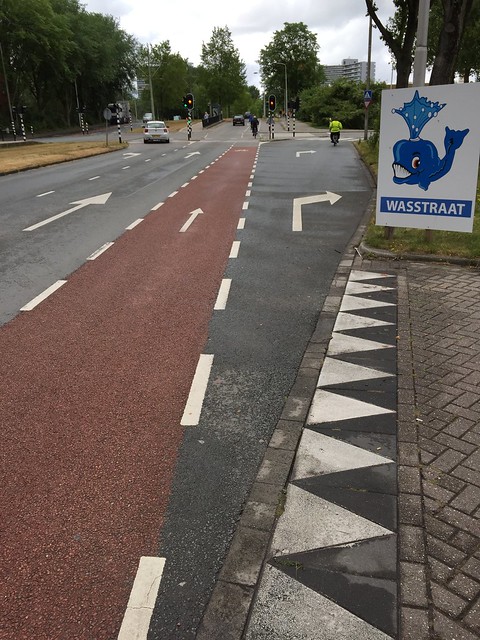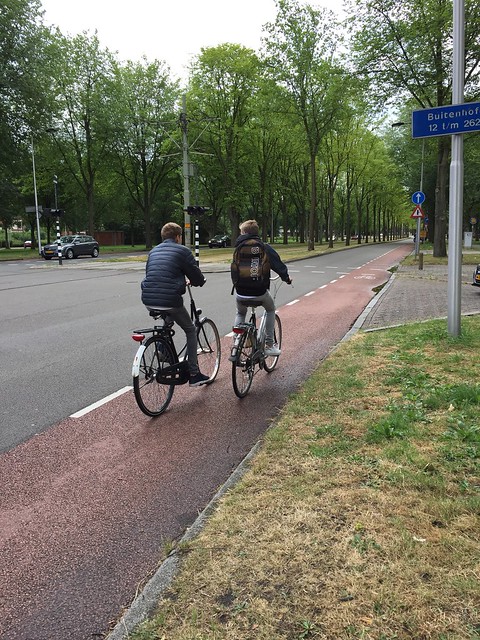Bike Lanes
Christine McGeein, Chase McLaughin, David Roglieri, Tiffany Ma, William Huang
Overview:
A bike lane is a lane on the road separated from motor vehicle travel lanes by a white lane line, either dashed, or solid as seen in Figure 6. Usually the bike lane pavement is a different color and is marked with a bicycle logo. Bike lanes are only to be used by bikes and cars should not enter the lane. There is no physical separation between the bike lane and main road. Figure 7 shows a locus map of the locations explored.
Figure 1: Bike lane in the middle of two car lanes
Figure 2: Bike lane locus map
Design:
Below are tables for street dimensions that were taken throughout studies.
Table 1: Buitenhofdreef
| Location | Street | Parallel Parking | No. Through Lanes | No. Turning Lanes | Speed Limit |
| B1 | Buitenhofdreef | no | 1 | 1 | 50 |
*speed limit not noted on street signs
| Left Turn Lane | Travel Lane | Bike Lane | |
| SB near side | 8′-6″ | 8′-5″ | 5′-10″ |
| SB far side | – | 12′-4″ | 5′-3″ |
*queue box on right side for left-turning bikes going SB, more commonly used by left-turning bikes turning NB, heading EB.
Table 2: Matrinus Nijhofflaan
| Location | Street | Parallel Parking | No. Through Lanes | No. Turning Lanes | Speed Limit |
| B2 | Martinus Mijhofflaan | no | 1 | 2 | 30 |
| Left Turn Lane | Travel Lane | Right Turn Lane | Bike Lane |
| 11′-3″ | 9′-6″ | 10′-3″ | 5′-9″ |
| 7′-2″ | 10′-0″ | – | 6′-0″ |
*right turn lane to the right of the bike lane, crosses over. Only at a few points on road.
Table 5: Julianlaan
| Location | Street | Parallel Parking | No. Through Lanes | No. Turning Lanes | Speed Limit |
| B5 | Julianlaan | Yes? | 2 | 0 | 30 |
| SB Bike | SB Travel | Parking | NB Travel | NB Bike | Medians |
| 5′-11″ | 9′-6″ | 18′-11″ | 10′-0″ | 6′-4″ | (2) 2′-0″ |
Pocket bike lanes are where the cyclist has a single lane running straight where the vehicle right turn lane cuts over the bike lane to go to the right. This intersection type is used on the Matrinus Nijhofflaan intersection that we measured. We rode through it as well as observed it. It seemed to work very efficiently and calmly. The cars let the bikes pass through ahead of them to queue at the front of the bike lane, and then they cut over to get into their turn lane. This works because the turn lane is short and abrupt, so the cars have already slowed down significantly for the turn. Also, the bike light allows the bikes to go a few seconds ahead of the cars so they can clear the intersection before the cars get to pass them.
Bike lanes are when the bikes have their own lane, kept off to the right of the cars so that cars potentially don’t see the bikes and turn into them. They can also be where the bike lane is actually offset from the car lane so that the car will begin to turn to face the bike while the bike approaches. This second option is much safer, because it increases visibility for the drivers and bicycles to avoid collisions. An additional option is where the bike lane actually merges into the right turn lane, so that the bikes are in the lane with the cars turning. This is definitely an example of vehicular cycling, but it does allow for the cars to see the bicycles and know where they are going. However merging into the car lane is no easy feat for the bicyclists, and could cause potential collisions or long pauses and wait times for the cyclists.
Bike lanes in the Netherlands are similar to the ones in the U.S. in that they are both on the right side of the road. Both also change the color of the bike lanes to make them stand out so drivers are more aware of them. The Netherlands, however, actually dyes the asphalt underneath bike lanes red, while the U.S. simply paints their bike lanes green. The Netherlands also has national standards for bike lanes, which include having bike signals, bike buttons for the signals, and yield pavement markings. The U.S. has not yet agreed on standards to use, which results in AASHTO and NACTO have disagreeing information. Because the Netherlands has developed a culture for cycling, drivers respect the bike lane while in the U.S., motorists park and drive in the bike lane.
In the Netherlands, bike lanes at intersections have their own crossing section and signals. Cyclists usually get their green light a few seconds before motorists do, to put them ahead in the motorists’ visibility. The Dutch are very focused on cyclist’s safety. The U.S. on the other hand, does not have create any sort of priority for bike lanes at intersections. Cyclists are expected to compete with motorists. The biggest danger from this is when a bike lane is on the right of a turning lane, and the driver does not see the cyclists as it makes the right turn, causing them to hit the cyclist.
Operations:
In the Netherlands bike lanes are used as intended. We have not seen a car drive in the bike lane and generally see all cyclists riding in the bike lane. Cars are very conscious of the bike lane and usually leave a large distance between the bike lane and where they are driving. Cyclists are almost always seen riding in the bike lane as long as there is one readily available. They typically ride in the center of the bike lane unless two cyclists are riding next to each other as seen in Figure 8. This same awareness between cyclists and motorists is not always practiced in the United States as it is in the Netherlands. An additional observation that we made is at Buitenhofdreef where there is a left turn box and a stop lane. In Figure 9, there are two possible locations for someone coming down the street perpendicular and crossing Buitenhofdreef’s tram tracks – the stop line and the que box. The que box was meant for cyclists biking down Buitenhofdreef but people, like the man in the wheelchair in Figure 9, would pass the stop lane if there is no traffic and wait at the que box to cross the tram tracks.
Figure 3: Biking in the bike lane
Figure 4: Two possible stop locations for a left turn at Buitenhofdreef



